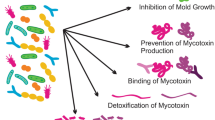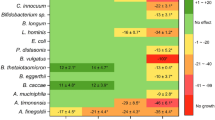Abstract
T-2 toxin, a toxic member of the group A trichothecenes, is produced by various Fusarium species that can potentially affect human health. As the intestine plays an important role in the metabolism of T-2 toxin for animals and humans, the degradation and metabolism of T-2 toxin was studied using the pig cecum in vitro model system developed in the author’s group. In order to study the intestinal degradation of T-2 toxin by pig microbiota, incubation was performed with the cecal chyme from four different pigs in repeat determinations. A large variation in the intestinal degradation of T-2 toxin was observed for individual pigs. T-2 toxin was degraded almost completely in one out of four pigs, in which only 3.0 ± 0.1 % of T-2 toxin was left after 24 h incubation. However, in the other three incubations with pig cecal suspension, 54.1 ± 11.7–68.9 ± 16.1 % of T-2 toxin were still detectable after 24 h incubation time. The amount of HT-2 toxin was increased along with the incubation time, and HT-2 toxin accounted for 85.2 ± 0.7 % after 24 h in the most active cecum. HT-2 toxin was the only detectable metabolite formed by the intestinal bacteria. This study suggests that the toxicity of T-2 toxin for pigs is caused by the combination of T-2 and HT-2 toxins.




Similar content being viewed by others
References
Anastassiades M, Lehotay SJ, Stajnbaher D, Schenck FJ (2003) Fast and easy multiresidue method employing acetonitrile extraction/partitioning and ‘dispersive solid phase extraction’ for the determination of pesticide residues in produce. J AOAC Int 86:412–431
Appeldoorn MM, Vincken JP, Aura AM, Hollman PC, Gruppen H (2009) Procyanidin dimers are metabolized by humanmicrobiota with 2-(3,4-dihydroxy-phenyl) acetic acid and 5-(3,4-dihydroxyphenyl)-γ-valerolactone as the major metabolites. J Agric Food Chem 57(3):1084–1092
Bennett JW, Klich M (2003) Mycotoxins. Clin Microbiol Rev 16(3):497–516
Betina V (1989) Structure–activity relationships among mycotoxins. Chem Biol Interact 71:105–146
Beyer M, Ferse I, Humpf H-U (2009) Large-scale production of selected type A trichothecenes: the use of HT-2 toxin and T-2 triol as precursors for the synthesis of d3-T-2 and d3-HT-2 toxin. Mycotoxin Res 25:41–52
Chatterjee K, Visconti A, Microcha CJ (1986) Deepoxy T-2 tetraol: a metabolite of T-2 toxin found in cow urine. J Agric Food Chem 34:695–697
Chi MS, Mirocha CJ, Kurtz HJ, Weaver G, Bates F, Shimoda W, Burmeister HR (1977) Acute toxicity of T-2 toxin in broiler chicks and laying hens. Poult Sci 56:103–116
Chi MS, Robison TS, Mirocha CJ, Swanson SP, Shimoda W (1978) Excretion and tissue distribution of radioactivity from tritiumlabeled T-2 toxin in chicks. Toxicol Appl Pharmacol 45:391–402
Coddington KA, Swanson SP, Hassan AS, Buck WB (1989) Enterohepatic circulation of T-2 toxin metabolites in the rat. Drug Metab Dispos 17:600–605
Corley RA, Swanson SP, Gullo GJ, Johnson L, Beasley VR, Buck WB (1986) Disposition of T-2 toxin, a trichothecene mycotoxin, in intravascularly dosed swine. J Agric Food Chem 34:868–875
Dohnal V, Jezkova A, Jun D, Kuca K (2008) Metabolic pathways of T-2 toxin. Curr Drug Metab 9:77–82
Edwards SG, Barrier-Guillot B, Clasen PE, Hietaniemi V, Pettersson H (2009) Emerging issues of HT-2 and T-2 toxins in European cereal production. World Mycotoxin J 2(2):173–179
Engemann A, Hübner F, Rzeppa S, Humpf H-U (2012) Intestinal metabolism of two A-type procyanidins using the pig cecum model: detailed structure elucidation of unknown catabolites with Fourier transform mass spectrometry (FTMS). J Agric Food Chem 60(3):749–757
Eriksen GS, Pettersson H (2004) Toxicological evaluation of trichothecenes in animal feed. Anim Feed Sci Tech 114(1–4):205–239
Forsell J, Kately JR, Yoshizawa T, Pestka J (1985) Inhibition of mitogen-induced blastogenesis in human lymphocytes by T-2 toxin and its metabolites. Appl Environ Microbiol 49(6):1523–1526
Fuchs E, Binder EM, Heidler D, Krska R (2002) Structural characterization of metabolites after the microbial degradation of type A trichothecenes by the bacterial strain BBSH 797. Food Addit Contam 19(4):379–386
Guan S, He J, Young C, Zhu H, Li XZ, Ji C, Zhou T (2009) Transformation of trichothecene mycotoxins by microorganisms from fish digesta. Aquaculture 290:290–295
Gutleb AC, Morrison E, Albertina JM (2002) Cytotoxicity assays for mycotoxins produced by Fusarium strains: a review. Environ Toxicol Pharmacol 11:309–320
Hein EM, Rose K, van’t Slot G, Friedrich AW, Humpf H-U (2008) Deconjugation and degradation of flavonol glycosides by pig cecal microbiota characterized by fluorescence in situ hybridization (FISH). Agric Food Chem 56(6):2281–2290
Huff WE, Doerr JA, Hamilton PB, Vesonder RF (1981) Acute toxicity of vomitoxin (deoxynivalenol) in broiler chickens. Poult Sci 60:1412–1414
JECFA (2001) T-2 and HT-2. Joint FAO/WHO Expert Committee on Food additives, 56th report. Safety evaluation of certain mycotoxins in food. WHO Food additives series 47. WHO. Geneva, 419–556. Available at: http://www.incherm.org/documents/jecfa/jecmono/v47je06.htm (Accessed on April 04, 2012)
Joffe AZ (1974) Toxicity of Fusarium poae and F. sporotrichoides and its relation to alimentary toxic aleukia. In: Purchase IFH (ed) Mycotoxins. Elsevier, Amsterdam, pp 229–262
Keppler K, Humpf H-U (2005) Metabolism of anthocyanins and their phenolic degradation products by the intestinal microflora. Bioorgan Med Chem 13:5195–5205
Keppler K, Hein EM, Humpf H-U (2006) Metabolism of quercetin and rutin by the pig cecal microflora prepared by freeze-preservation. Mol Nutr Food Res 50:686–695
Kiessling KH, Pettersson H, Sandholm K, Olsen M (1984) Metabolism of aflatoxin, ochratoxin, zearalenone, and three trichothecenes by intact rumen fluid, rumen protozoa, and rumen bacteria. Appl Environ Microbiol 47(5):1070–1073
King RR, McQueen PE, Levesque D, Greenhalgh R (1984) Transformation of deoxynivalenol (vomitoxin) by rumen microorganisms. J Agric Food Chem 32:1181–1183
Kollarczik B, Gareis M, Hanelt M (1994) In vitro transformation of the Fusarium mycotoxins, deoxynivalenol and zearalenone, by the normal gut microflora of pigs. J Nat Toxins 2:105–110
Königs M, Mulac D, Schwerdt G, Gekle M, Humpf H-U (2009) Metabolism and cytotoxic effects of T-2 toxin and its metabolites on human cell in primary culture. Toxicology 258:106–115
Li Y, Wang Z, Beier RC, Shen J, Smet DD, Saeger SD, Zhang S (2011) T-2 toxin, a trichothecene mycotoxin: review of toxicity, metabolism, and analytical methods. J Agric Food Chem 59:3441–3453
Moss MO (2002) Mycotoxin review-2. Fusarium. Mycologist 16:158–161
Robison TS, Mirocha CJ, Kurtz HJ, Behrens JC, Weaver GA, Chi MS (1979) Distribution of tritium-labeled T-2 toxin in swine. J Agric Food Chem 27:1411–1413
Sergent T, Parys M, Garsou S, Pussemier L, Schneider YJ, Larondelle Y (2006) Deoxynivalenol transport across human intestinal Caco-2 cells and its effects on cellular metabolism at realistic intestinal concentrations. Toxicol Lett 164:167–176
Swanson SP, Helaszek C, Buck WB, Rood HD Jr, Haschek WM (1988) The role of intestinal microflora in the metabolism of trichothecene mycotoxins. Food Chem Toxicol 26:823–829
Trebstein A, Lauber U, Humpf H-U (2009) Analysis of Fusarium toxins via HPLC-MS/MS multimethods: matrix effects and strategies for compensation. Mycotoxin Res 25:201–213
van’t Slot G, Humpf H-U (2009) Degradation and metabolism of catechin, epigallocatechin-3-gallate (EGCG), and related compounds by the intestinal microbiota in the pig cecum model. J Agric Food Chem 57:8041–8048
van’t Slot G, Mattern W, Rzeppa S, Grewe D, Humpf H-U (2010) Complex flavonoids in cocoa: synthesis and degradation by intestinal microbiota. J Agric Food Chem 58:8879–8886
Weidner M, Welsch T, Hübner F, Humpf H-U (2012) Identification and apoptotic potential of T-2 toxin metabolites in human cells. J Agric Food Chem 6(22):5676–5684
Wu Q, Dohnal V, Huang L, Kuča K, Yuan Z (2010) Metabolic pathways of trichothecenes. Drug Metab Rev 42(2):250–267
Yoshizawa T, Mirocha CJ, Behrens JC, Swanson SP (1981) Metabolic fate of T-2 toxin in a lactating cow. Food Cosmet Toxicol 19:31–39
Yoshizawa T, Takeda H, Ohi T (1983) Structure of a novel metabolite from deoxynivalenol, a trichothecene mycotoxin, in animals. Agric Biol Chem 47:2133–2135
Yoshizawa T, Sakamoto T, Kuwamura K (1985) Structures of deepoxytrichothecene metabolites from 3′-hydroxy HT-2 toxin and T-2 tetraol in rats. Appl Environ Microbiol 50:676–679
Young JC, Zhou T, Yu H, Zhu H, Gong J (2007) Degradation of trichohtecene mycotoxins by chicken intestinal microbes. Food Chem Toxicol 45:36–143
Acknowledgments
We thank the Kurzen family (Gut Wewel, Senden, Germany) for providing the ceca. This study was supported by a fellowship to Q.W. from the China Scholarship Council and a fellowship to A.E. from the NRW Graduate School of Chemistry. Furthermore, the project was funded by the National Basic Research Program of China (2009CB118800)
Conflict of interest
The authors declared no conflict of interest.
Author information
Authors and Affiliations
Corresponding author
Additional information
Qinghua Wu and Anna Engemann contributed equally to this work.
Rights and permissions
About this article
Cite this article
Wu, Q., Engemann, A., Cramer, B. et al. Intestinal metabolism of T-2 toxin in the pig cecum model. Mycotoxin Res 28, 191–198 (2012). https://doi.org/10.1007/s12550-012-0134-y
Received:
Revised:
Accepted:
Published:
Issue Date:
DOI: https://doi.org/10.1007/s12550-012-0134-y




